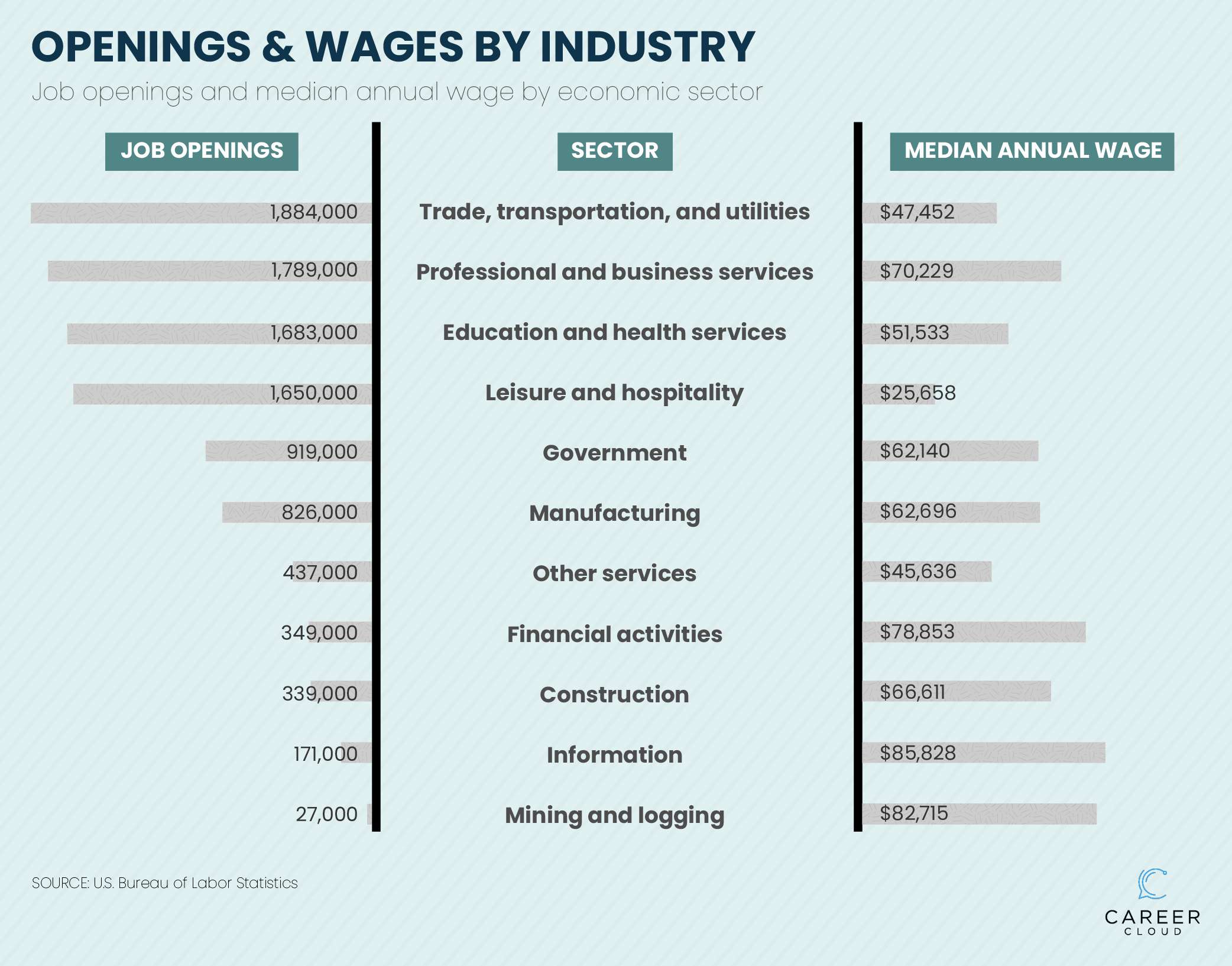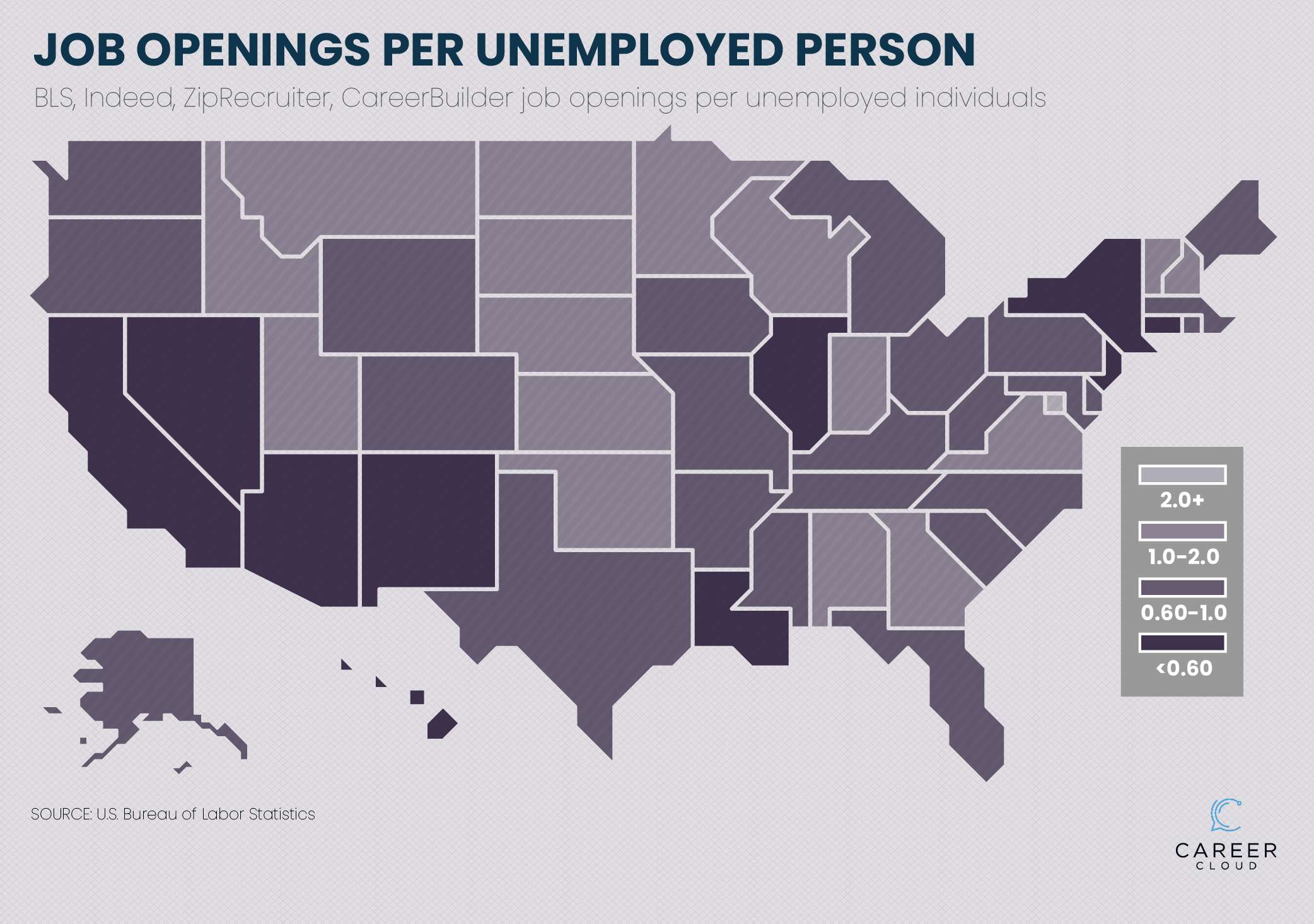As of October 2021, there are 10.4 million unfilled jobs in America and 8.3 million unemployed Americans. In theory, there are enough jobs for everyone with 2.1 million jobs left over. There are enough open jobs to employ every American. But businesses across the country are facing a huge labor shortage. Some businesses have changed their hours because they can't cover all shifts, while others have shuttered entirely. Some have boosted their standard hourly wages, while others have offered added benefits like covering vision and dental insurance or paying out hiring bonuses.
Many observers have suggested that expanded unemployment benefits are keeping people from seeking jobs, while others blame the issue on the fallout from the COVID-19 pandemic. Childcare, skills gaps, and other causes are likely also playing a role.
Regardless of the reasons for businesses having difficulty filling open jobs, the truth is that the picture is much different from state to state.
Unemployment rates, economic conditions, and job openings all vary widely across the country, and we wanted to understand which states are best for employers looking to find qualified workers (and workers hoping to find satisfying, well-paying jobs). We analyzed data from the U.S. Bureau of Labor Statistics (BLS), as well as job boards Indeed, ZipRecruiter, and CareerBuilder to create a picture of job openings across the country.
Here are some of our key findings:
-
Hawaii has the fewest job openings per unemployed people, 0.41 jobs per person. The District of Columbia has the most, 2.37 per person.
-
Nevada's jobless rate has dropped the most over the past year, falling by nearly nine percentage points. Kentucky's has declined by just over one point since the summer of 2020.
-
Three of the four industries with the highest number of job openings have annual wages that are well under the national median, while the highest-paying sector (information) has the second-lowest number of available jobs.
Job Recoveries Vary by State
The most recent unemployment rate in the U.S. was 5.4 percent, with almost 9 million people being unemployed. While that's a drop from the worst depths of the pandemic, when unemployment reached almost 15 percent, the jobless rate remained elevated from pre-pandemic levels. February 2020, before the pandemic crisis began, 3.5 percent of Americans were unemployed.
Unemployment rates vary across the country, from a high of 7.7 percent in Nevada to a low of 2.3% in Nebraska.

Unemployment rate by state, July 2021
| Nevada | 7.7% |
|---|---|
| California | 7.6% |
| New Mexico | 7.6% |
| New York | 7.6% |
| Connecticut | 7.3% |
| Hawaii | 7.3% |
| New Jersey | 7.3% |
| Illinois | 7.1% |
| District of Columbia | 6.7% |
| Alaska | 6.6% |
| Arizona | 6.6% |
| Louisiana | 6.6% |
| Pennsylvania | 6.6% |
| Texas | 6.2% |
| Colorado | 6.1% |
| Mississippi | 6.1% |
| Maryland | 6.0% |
| Rhode Island | 5.8% |
| Delaware | 5.6% |
| Ohio | 5.4% |
| Oregon | 5.2% |
| Wyoming | 5.2% |
| Florida | 5.1% |
| Washington | 5.1% |
| West Virginia | 5.0% |
| Maine | 4.9% |
| Massachusetts | 4.9% |
| Michigan | 4.8% |
| Tennessee | 4.7% |
| Kentucky | 4.4% |
| North Carolina | 4.4% |
| Arkansas | 4.3% |
| South Carolina | 4.3% |
| Missouri | 4.2% |
| Virginia | 4.2% |
| Indiana | 4.1% |
| Iowa | 4.1% |
| Minnesota | 3.9% |
| North Dakota | 3.9% |
| Wisconsin | 3.9% |
| Kansas | 3.8% |
| Georgia | 3.7% |
| Montana | 3.6% |
| Oklahoma | 3.5% |
| Alabama | 3.2% |
| Idaho | 3.0% |
| Vermont | 3.0% |
| New Hampshire | 2.9% |
| South Dakota | 2.9% |
| Utah | 2.6% |
| Nebraska | 2.3% |
Every state has seen its unemployment rate decline since 2020 when hiring remained low and many businesses across the nation were still closed. Nevada has had the biggest rebound, as its jobless rate has tumbled by almost nine points over the past year.

Percentage point decline in unemployment rate by state, July 2020-July 2021
.tg .tg td{border-color:black;border-style:solid;border-width:1px;font-family:Arial, sans-serif;font-size:14px; overflow:hidden;padding:10px 5px;word-break:normal;} .tg th{border-color:black;border-style:solid;border-width:1px;font-family:Arial, sans-serif;font-size:14px; font-weight:normal;overflow:hidden;padding:10px 5px;word-break:normal;} .tg .tg-0lax
| Nevada | 8.9 |
|---|---|
| Rhode Island | 8.2 |
| New York | 7.1 |
| Hawaii | 6.8 |
| Florida | 6.4 |
| Pennsylvania | 6.4 |
| New Jersey | 5.8 |
| Washington | 5.7 |
| California | 5.6 |
| New Hampshire | 5.2 |
| Illinois | 4.9 |
| Massachusetts | 4.9 |
| New Mexico | 4.9 |
Join The Break Community
| Indiana | 4.5 | | Oregon | 4.4 | | Alaska | 4.4 | | North Carolina | 4.4 | | West Virginia | 4.4 | | Alabama | 4.2 | | Michigan | 4.2 | | Tennessee | 4.2 | | Connecticut | 4.0 | | Georgia | 3.9 | | Ohio | 3.9 | | Maine | 3.9 | | Arizona | 3.8 | | Minnesota | 3.7 | | Virginia | 3.7 | | Oklahoma | 3.7 | | Vermont | 3.4 | | South Carolina | 3.3 | | Wisconsin | 3.3 | | Texas | 3.1 | | Montana | 3.0 | | Idaho | 2.9 | | Kansas | 2.8 | | Utah | 2.8 | | Arkansas | 2.8 | | Delaware | 2.7 | | Maryland | 2.7 | | Missouri | 2.6 | | South Dakota | 2.5 | | Louisiana | 2.5 | | Mississippi | 2.4 | | North Dakota | 2.3 | | District of Columbia | 2.2 | | Nebraska | 2.1 | | Iowa | 2.0 | | Wyoming | 1.6 | | Colorado | 1.3 | | Kentucky | 1.2 |
Where the Jobs Are (or Aren’t)
With more than 10 million job openings reported by the BLS and almost 9 million people jobless, the simple math would seem to indicate there’s a job for every person. But the reality is much more complicated, and some of the best-paying industries — information, mining and logging, and financial activities have the highest median wages — are near the bottom when it comes to available job openings.
Among the sectors with more than a million job openings, only one (professional and business services) offers a median wage that’s higher than the overall national median of about $56,000.

Job openings by industry, June 2021

The number of unemployed people and job openings vary across the country. Taking into account the most recent BLS data on job openings by state as well as averages from three major job boards, the District of Columbia has the highest ratio of unemployed individuals to job openings, with 2.37 openings per jobless person. Hawaii’s job market appears to be the best for employers, with 0.41 jobs per unemployed individual.

Average job openings per unemployed person
Hiring & Getting Hired in the Age of COVID
.tg .tg td{border-color:black;border-style:solid;border-width:1px;font-family:Arial, sans-serif;font-size:14px; overflow:hidden;padding:10px 5px;word-break:normal;} .tg th{border-color:black;border-style:solid;border-width:1px;font-family:Arial, sans-serif;font-size:14px; font-weight:normal;overflow:hidden;padding:10px 5px;word-break:normal;} .tg .tg-lqy6 .tg .tg-0lax
| District of Columbia | 2.37 |
|---|---|
| Nebraska | 1.80 |
| New Hampshire | 1.60 |
| Vermont | 1.59 |
| Utah | 1.45 |
| South Dakota | 1.44 |
| Idaho | 1.29 |
| Montana | 1.21 |
| North Dakota | 1.20 |
| Georgia | 1.12 |
| Alabama | 1.10 |
| Oklahoma | 1.08 |
| Virginia | 1.04 |
| Wisconsin | 1.04 |
| Kansas | 1.03 |
| Indiana | 1.02 |
| Minnesota | 1.01 |
| Iowa | 0.99 |
| Kentucky | 0.99 |
| Massachusetts | 0.98 |
| North Carolina | 0.97 |
| Missouri | 0.96 |
| South Carolina | 0.93 |
| Maine | 0.91 |
| Tennessee | 0.89 |
| Arkansas | 0.86 |
| West Virginia | 0.84 |
| Michigan | 0.81 |
| Oregon | 0.80 |
| Wyoming | 0.78 |
| Ohio | 0.77 |
| Washington | 0.75 |
| Delaware | 0.74 |
| Maryland | 0.73 |
| Florida | 0.70 |
| Alaska | 0.68 |
| Rhode Island | 0.68 |
| Pennsylvania | 0.67 |
| Colorado | 0.64 |
| Texas | 0.61 |
| Mississippi | 0.60 |
| Illinois | 0.59 |
| New Jersey | 0.59 |
| Arizona | 0.56 |
| New Mexico | 0.53 |
| Louisiana | 0.52 |
| Connecticut | 0.51 |
| Nevada | 0.50 |
| California | 0.45 |
| New York | 0.45 |
| Hawaii | 0.41 |
As we mentioned, there are many issues contributing to the current workforce shortage affecting many businesses, and while the pandemic is only one of them, it’s likely that the past year has caused a shift in how Americans view work, according to Northeastern University economics professor Robert Triest.
More people are simply unwilling to work under the conditions they experienced before the pandemic, especially after many of them had to manage job loss, hours cutbacks, home-schooling children, and more.
“For the most part, it’s not a shortage of workers that’s the problem, per se. It’s a sign that employers just need to offer better packages of wages and working conditions to attract workers,” Triest said.
They want higher wages, expanded healthcare benefits, and more flexibility in their schedules, and many remain concerned about potential workplace exposure to COVID-19. With that in mind, here are our recommendations for companies hiring workers right now as well as people seeking a new job.
5 Tips to Effectively Hire During the Current Labor Shortage
1. Pay Above the Market Rate
For perhaps the first time, minimum wage workers have leverage due to government aid and are holding out for higher pay. The number of $15 an hour job postings has doubled on ZipRecruiter since 2019 and companies like McDonald’s, Amazon, and Chipotle have raised pay this year for hundreds of thousands of workers. Business owners of all sizes will need to increase pay to keep up. For more related tips, check out our guide on how to find employees.
2. Lean into Remote Work in the Short and Long Term
Giving employees the chance to work from home now, as the delta variant spreads, is a must. Additionally, a McKinsey survey found that even after the pandemic, 52 percent of workers want a hybrid model working from home and the office. Allowing those who can, to work from home will be an enormous long-term incentive.
3. Incentivize Commuting for Jobs That Must be Done In-Person
Now that people learned they can work remotely and earn similar money, they do not want to commute. Harvard Business Review research found a 1% increase in distance to work leads to a 4.4% decrease in commuting flow across the country. Employers could subsidize commuting costs, provide a corporate shuttle, and offer longer but fewer shifts.
4. Be Flexible with Parental Leave
It is difficult for both parents to return to work with children in and out of school. With no substantive government guidance in place, businesses must act. Hewlett-Packard launched a "Work That Fits Your Life" program that offers six months of fully paid parental leave for new moms and dads with an option to work part-time for up to 36 months. For smaller businesses, being compassionate and flexible with parental leave will attract candidates.
5. Make Sure Your Recruiting Process Is On-Point
As an employer, make sure your recruiting process is dialed in. Utilize the best free job posting sites when posting job openings, take advantage of helpful software like ATS software, recruiting software, and HR software, and utilize resume search functions on job hiring platforms.
Conclusion
It’s easy to blame the pandemic for creating upheaval in the job market. And to be sure, the ongoing crisis is having an effect. But the reality is that jobseekers today want what they’ve always wanted; the difference is that they now realize they have options in a way they may not have before. For employers, it may cost a bit more in salary and benefits to make the best hire, but treating workers well will pay dividends in the long run.
Methodology
We compared the number of unemployed people in each state -- using data from the U.S. Bureau of Labor Statistics – against the number of unfilled jobs in each state using the most recent BLS data, which was from March with new data not expected until the fall. To create a real-time analysis, we also used job openings reported in August on Indeed, ZipRecruiter, and CareerBuilder. The average number of job openings across BLS and the three job boards was then compared to the number of unemployed people in each state to find how many unfilled jobs exist per unemployed person in each state. We also linked directly to sources within the study.













